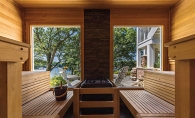With nearly 40 years of experience in the design and build industry, architect Jon Monson of design/build firm Landschute Group has made a habit of renovating lake-area homes.
Monson started his career working in the warehouse district in Minneapolis doing renovation work on historic warehouses. In 1990, he started on his first reuse project in the Cottagewood neighborhood, where he dismantled a small structure and reused elements from it in new construction. Though it wasn’t a full-blown renovation, it was then that he started to reuse vintage elements in his designs. Then in 1993, just a few blocks away, Monson built a home for his own family using material from an old structure located there.
“[The original house] didn’t fit our needs, so we dismantled it board by board and reused the material in refinishing the interior,” he explains.

Lakeview before the renovation .
It was that process that whet Monson’s appetite for home renovation and bringing the original character and life back to historic homes around the lake. Over the years, as Monson would come across old houses and as he saw more old structures being torn down, he started paying more attention to what the potential for reuse or renovation might be for these old structures.
Fast-forward to today, and he says Landschute Group seems to always have at least one home renovation project going on. Monson himself is even out scouting old structures that are worthy of being saved.
Monson and his wife, Mary, now live in a different home that they renovated themselves. Throughout the home, the Monsons used original elements of the 1892 cottage, incorporating old street-side railings into the new balcony, preserving a beadboard soffit and reinstalling the floor from the former porch in the master bathroom.
When starting a home renovation, Monson and his team approach the process as both the architect and builder, creating a seamless integration of design and build. But the first step for anyone looking to renovate a home is figuring out the scale of the entire renovation project. “First you have to identify how far backward you want to go, before you go forwards,” Monson says.
Often this can largely depend on the budget for the project. Once that’s established, then the designer and/or builder can help prioritize what’s possible. Monson says, “It’s a juggling act—a little bit more than if you were starting from scratch.”
Reusing existing materials and design elements from the historic structure can also help cut down on expenses, as opposed to buying brand-new items. For example, when finishing out a home renovation, Monson will typically reuse as much as he can.


Irving renovatioin before and after photos.
“Many times we’ll reuse flooring. And over the years, we have assembled quite a warehouse of old materials, doors, windows and hardware,” he says.”
Sometimes homeowners choose a hybrid process of blending the new with the old as part of the renovation. When Landschute works on a project like this, they may strip the house back to the bones, and install all new systems—electrical, mechanical, and plumbing.
Regardless of the scale of the home renovation, the most important thing to do is get a design and build professional—preferably one who specializes in old structures—involved as soon as possible.
And though the thought of renovating an old structure to its prior days of glory may sound like opening a can of worms, Monson says that whatever problems arise are always manageable. However, the process will go more smoothly if the homeowner and design professional do a thorough evaluation in the beginning, before the work starts.
But regardless of the possibility of unforeseen issues, Monson sees the risk as well worth the reward.
“We’ve realized there are stories in these [homes’] walls; it’s more than just a static bunch of two-by-fours,” he says. “There’s a past, and it makes the process so much more fun and rewarding when you can breathe life into something everyone thought should be torn down.”









